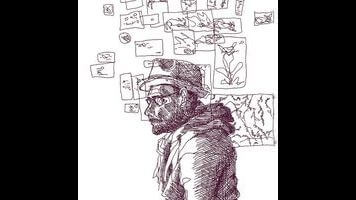You can identify a Mark Z. Danielewski book from a single page—no need to even read it. Since the start of his literary career—2000’s still-mind blowing House Of Leaves, the first of his books to both astonish and unsettle—Danielewski has employed a complex and visual form of writing, a multidimensional means of amplifying the impact of his stories and prose. There’s something cinematic about his work; inserted images act as rudimentary special effects while page layouts serve as both camera angles and edits, designed in such a way that they reflect the narrative and provide pauses. When a character stops to think, there’s a page break. When a character whispers, Danielewski downshifts into a smaller font. The effect is visceral.
This style, what Danielewski calls “signiconic” literature, reaches its apex in The Familiar, an epic story with 27 planned volumes, of which Into The Forest is the second. As he did with the first volume, One Rainy Day In May (released earlier this year), Danielewski juggles nearly 10 major story lines and characters, each identifiable at a glance thanks to the unique structure of their chapters; in some, the prose is written in squares of text, while in others it covers half the page or forms the outline of a circle. Once again, though, the story’s focus is centered on a girl named Xanther. In the first book, Xanther rescued a kitten that she discovered through mysterious means. Here, the kitten begins to exhibit strange behavior. Along the way are riffs on pop culture both highbrow and low as Danielewski name checks and draws references from everything from movies and apps to celebrities and internet memes.
That’s all plot summary that will be revealed here, as, A) revealing more would spoil the fun of discovery, B) the book is more about mood than the specific twists and turns, and C) trying to condense an explanation is nigh-impossible. Suffice to say, readers who enjoy sussing their way through challenging material—the series at times recalls Ulysses, Infinite Jest, and Cloud Atlas in its complexity, structure, and echoing parallel narratives—will find this a delectable challenge.
As for those who don’t want to draw diagrams and consult message boards to fully understand the proceedings, well, that’s tougher. The pleasures are real—early pages feature text interspersed between parentheses marks that visually recall the first volume’s rainfall; have you ever before considered a text-only page beautiful?—but given the story will have another 25 entries before its completion, it may be inevitable that the book is more fulfilling on a page-by-page basis rather than as a whole. (Into The Forest is probably “easier” to read than House Of Leaves, but that was more manageable because it was self-contained.) Presumably the full design of Danielewski’s world will have taken shape by the conclusion to Volume XXVII, but who knows what good that will do for readers attempting to get ahold of things in the early going. There is a palpable sense that his multifaceted narrative is moving somewhere, set to collide in ways both predictable and not, but still, Into The Forest feels more wind-up than pitch.
How one responds to it may depend on how they react to the signiconic elements. While the story is built around the style, there are times when it obfuscates the work. Here’s a sentence from an early chapter:
On their mantel (still) sits his present to her: two savage wolves (glass (by [blurred text] (Astair can’t surface the name))) ((here ((before her) as present and memory)) forever frozen in the middle of their courtship (his teeth (or are those hers?) scraping against the wide lunging neck (both animals (Lares & Penates) sexless (even if their evident desire for closure (consummation!) is obvioius in their together-surge upward towards a moon as invisible as it is out of reach))) forever undisturbed by moonlight (even breezes (whether stirring or cyclonic)) (if only light ((candlelight (say)) flickering wickedly) could grant glass movement and maybe consummation (closure!) along with the possibility (after closure (consolation!)) of bounding off the mantelpiece (as Dov and Astair had dreaming of doing in every situation they (ever) found themselves (they were not (never!) for each other)) or just continue tearing away at each other ((though they were never for each other) they had done that plenty of times) and copulating (that too ((lots and lots of it) and still not a match))) with only dust now to still (maybe (or at least (still) mutating the alchemy of light)) the conclusion this work (still) persistently suggests to Astair (achievable neither with celerity nor patience (just inevitable (even if the inevitable needs dusting now and then)))).
That cacophony of words can be parsed through, though the required effort stalls the momentum in ways that hurt the story (not every sentence is like that; that would be unreadable). Like The Country Of Ice Cream Star, a post-apocalyptic novel written in a mutated form of English, the style is done well, but it requires readers to be on a narrow wavelength. If you can’t get on, you’ll struggle. The literary world is stronger for having boundary pushers like Danielewski, but you know if you’re on his team.


 Keep scrolling for more great stories from A.V. Club.
Keep scrolling for more great stories from A.V. Club.